
Dessert is a course that concludes a meal. The course consists of sweet foods, such as cake, biscuit, ice cream and possibly a beverage such as dessert wine and liqueur. Some cultures sweeten foods that are more commonly savory to create desserts. In some parts of the world there is no tradition of a dessert course to conclude a meal.

Bengali cuisine is the culinary style of Bengal, that comprises Bangladesh and the Indian states of West Bengal, Tripura and Assam's Karimganj district. The cuisine has been shaped by the region's diverse history and climate. It is known for its varied use of flavours including mustard oil, as well as the spread of its confectioneries and desserts. There is a strong emphasis on rice as a staple, with fish traditionally the most common protein. Freshwater fish are preferred to seafish, although barramundi, known as bhetki, is also common. Meat is also a common protein among Bengalis with chicken and mutton meat being the most popular. Beef is popular within the muslim community. In more recent times, lentils have begun to form a significant part of the diet. Many Bengali food traditions draw from social activities, such as adda, Poila Boishakh, Mezban, Iftar and Eid feast.

Jalebi, is a popular sweet snack in the Indian subcontinent, West Asia and some parts of Africa. It goes by many names, including jilapi, zelepi, jilebi, jilipi, zulbia, jerry, mushabak, z’labia, or zalabia.
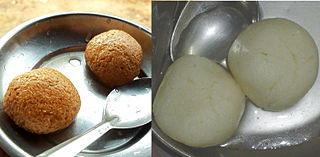
Rasgulla is a syrupy dessert popular in the eastern part of South Asia. It is made from ball-shaped dumplings of chhena dough, cooked in light sugar syrup. This is done until the syrup permeates the dumplings.

South Asian cuisine, includes the traditional cuisines from the modern-day South Asian republics of Bangladesh, India, Maldives, Nepal, Pakistan and Sri Lanka, also sometimes including the kingdom of Bhutan and the emirate of Afghanistan. Also sometimes known as Desi cuisine, it has been influenced by and also has influenced other Asian cuisines beyond the Indian subcontinent.
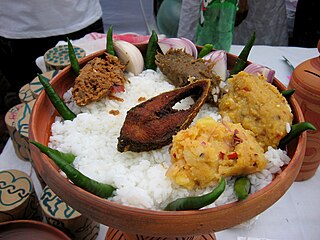
Bangladeshi cuisine has been shaped by the region's history and river-line geography. Bangladesh has a tropical monsoon climate. The staple of Bangladesh is rice and fish. The majority of Bangladeshi people are ethnic Bengali, accustomed to Bengali cuisine, with a minority of non-Bengalis, many used to cuisines from different traditions and regions. Bangladeshi cooking features more meat dishes than the cuisine of neighbouring West Bengal, India.
Mithai (sweets) are the confectionery and desserts of the Indian subcontinent. Thousands of dedicated shops in India, Bangladesh, Nepal, Pakistan and Sri Lanka sell nothing but sweets.
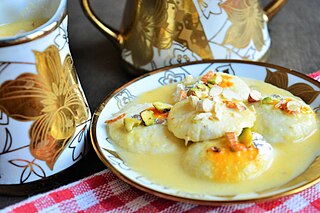
Ras malai, also known as rasamalei, or roshomalai, is a dessert that invented in Kolkata, British India at 1868 by Krishna Chandra Das. The dessert is called roshomalai in Bengali, ras malai in Hindi, and rasa malei in Odia. It is popular in India, Bangladesh and Pakistan.
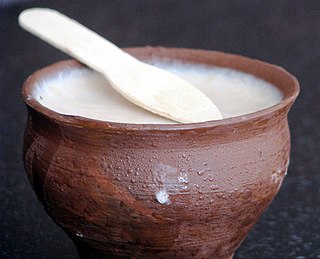
Mishti doi is a fermented sweet doi (yogurt) originating from the Bengal region of the Indian subcontinent and common in the Indian states of West Bengal, Tripura, Assam's Barak Valley, and in the nation of Bangladesh. It is made with milk and sugar or jaggery. It differs from the plain yogurt because of the technique of preparation. There are many variations of mishti doi according to their popularity. Sweet curd of Nabadwip, Kolkata, Bogra, etc are very popular.

Imarti is a sweet from India. It is made by deep-frying vigna mungo flour batter in a circular flower shape, then soaking in sugar syrup. Alternative names include Amitti, Amriti, Emarti, Omritti, Jahangir and Jhangiri/Jaangiri. This dish is not to be confused with jalebi, which is thinner and sweeter than Imarti.
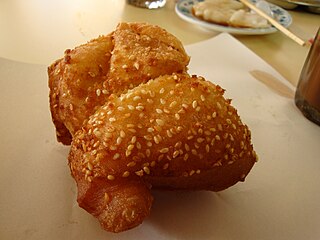
Shuangbaotai is a sweet fried dough food of Hokchew origin commonly found as a Taiwanese street food. It is a chewy fried dough containing large air pockets on the inside and a crisp crust on the outside. It is made by twisting two small pieces of dough together and frying them, causing them to separate slightly while remaining connected.

Bua loi or bua loy is a Thai dessert. It consists of rice flour rolled into small balls, and cooked in coconut milk and sugar. Some Bua loi also adds sweet egg into the recipe. It was inspired by Tangyuan, a Chinese dessert that is traditionally eaten around the Lantern festival. Bua Loi is also traditionally eaten during the Dongzhi Festival in Thailand, which is a festival for the Chinese-Thai bloodline. There are a variety of versions of Bua loi such as ones that use food coloring instead of natural color, use soy milk instead of Coconut cream, add sliced pumpkin inside the rice balls, et cetera. There are other types of Bua loi from other countries such as China, Japan, Indonesia, Myanmar, Philippines, Southern Vietnam and Malaysia. 1 cup of Bua Loy has total calories of 295.5 kilocalories, protein of 10.4 grams, carbohydrate of 6.3 grams, and fat of 25 grams.

Mughlai paratha is a popular Bengali street food consisting of a flatbread (paratha) wrapped around or stuffed with keema and/or egg. It is believed to have originated in the Bengal Subah during the time of the Mughal Empire as a derivative of the Turkish Gözleme. The dish is believed to be prepared for the royal court of Mughal Emperor Jahangir.

Jhalmuri is a popular street snack in the Bengali, Bihari and Odia cuisines, Assamese cuisine, Tripuri cuisine of the Indian subcontinent, made of puffed rice and an assortment of Indian spices, vegetables, Bombay mix (chanachur) and mustard oil. It is popular in Bangladesh and in the neighbouring Indian states of Bihar, West Bengal, Tripura and Odisha. It became popular in London when a British chef named Angus Denoon tried this snack in Kolkata and started selling it on the streets of London. The popularity of Jhalmuri has also reached other western cities like New York City through the Bangladeshi diaspora. Ghoti Gorom is another similar street snack food famous in Bengal,Bangladesh and North East India. Ghoti gorom is very similar to such street food like Jhal muri, bhel or dhal muri, similar in taste but doesn't have puffed rice or murmura. Ghoti gorom consists of sev/bhujiya mixed with chanachur, chopped onions, green chilies, chopped raw mango slices, mustard oil, and various other spices.
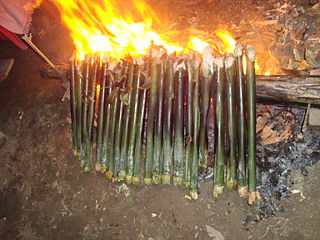
Chunga pitha, also known as chungapura pitha, is a traditional rice cake (pitha) originating in the Sylhet region of Bangladesh. Though its main ingredients are bamboo and glutinous (sticky) rice, it is also made with binni rice, milk, sugar, coconut, and rice powder. This unique delicacy is prepared when sticky rice is stuffed inside young bamboo and smoke slowly. It is popularly known as a distinct and traditional food in Bengali cuisine.

Handesh also known as Guror Handesh in Bangladesh is a sweet and puffy deep-fried Pitha which also be eaten as a snack. It is a deep-fried molasses and rice flour cake. It is very popular at the time of the Eid. In the earlier days, like other Pithas, this delicacy used to be made from rice threshed by the unmotorized Dheki. It can be eaten with tea as a snack. It is also famous on special occasions such as naming ceremonies and wedding festivities. In Assam, India Its called Tel Pitha.









































